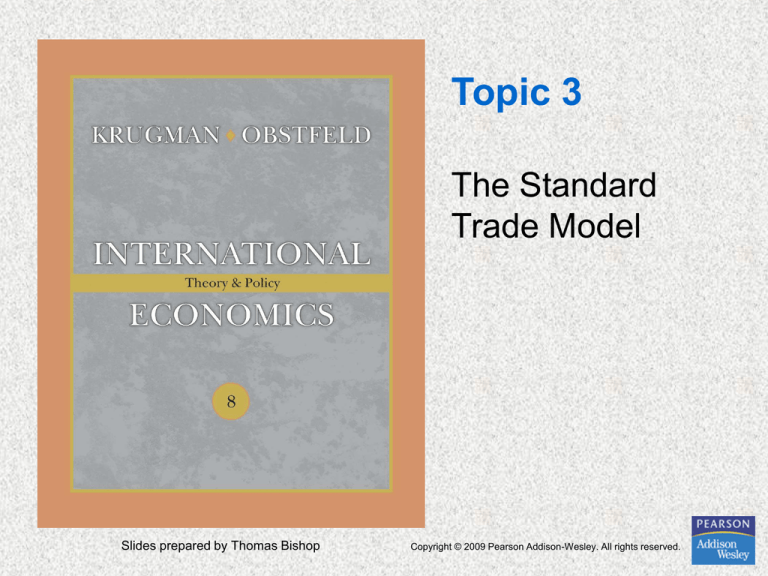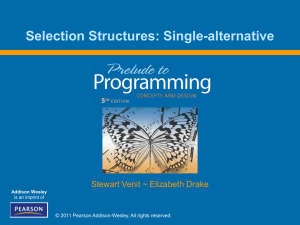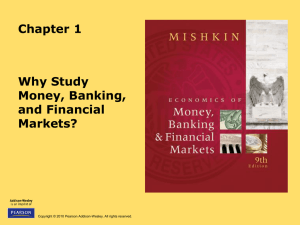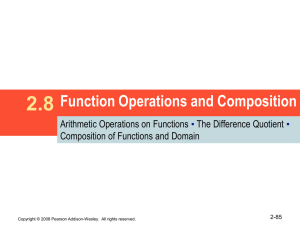
Topic 3
The Standard
Trade Model
Slides prepared by Thomas Bishop
Copyright © 2009 Pearson Addison-Wesley. All rights reserved.
Preview
• Measuring the values of production
and consumption
• Welfare and terms of trade
• Effects of economic growth
• Effects of international transfers of income
• Effects of import tariffs and export subsidies
• Income distribution
Copyright © 2009 Pearson Addison-Wesley. All rights reserved.
5-2
Introduction
•
Standard trade model combines ideas from
the Ricardian and H-O models.
1. Differences in L services, L skills, K, T, and
technology between countries cause productive
differences, leading to gains from trade.
2. These productive differences are represented as
differences in PPFs.
3. A country’s PPF determines its RS curve.
4. World equilibrium is determined by the
intersection of RD and RS which occurs
somewhere between national RS curves.
Copyright © 2009 Pearson Addison-Wesley. All rights reserved.
5-3
The Value of Production
• When the economy maximizes its production
possibilities, the value of output V lies on the
PPF.
• V = PCQC + PF QF describes the value of
output at market prices,
and when this value is constant the equation’s line
is called an isovalue line.
Slope of the isovalue line equals – (PC /PF), and if
∆(PC /PF) → ∆slope.
Copyright © 2009 Pearson Addison-Wesley. All rights reserved.
5-4
Fig. 1: Relative Prices Determine Output
As we move farther from
the origin, the value of
output is increasing.
Optimally, the economy
produces the highest level
of output it can where the
PPF is tangent to the
isovalue line.
0
Fig. 2: How an Increase in the Price of Cloth
Affects Output
If ↑(PC/PF) → the isovalue
line becomes steeper.
As ↑(PC/PF) → the economy
produces more cloth and less
food.
The Value of Consumption
• The value of the economy’s consumption
must equal the value of its production.
PC DC + PF DF = PC QC + PF QF = V
• Production and consumption points must lie
on the same isovalue line.
• What determines consumption choices
(demand)?
Copyright © 2009 Pearson Addison-Wesley. All rights reserved.
5-7
The Value of Consumption (cont.)
• Consumer tastes and prices determine
consumption choices.
• Consumer preferences are represented by
indifference curves: combinations of goods
that make consumers equally satisfied
(indifferent).
Each consumer has her own preferences, but we
assume that we can represent the tastes of an
average consumer that represents all consumers.
This implies all tastes are identical, as are
incomes.
Copyright © 2009 Pearson Addison-Wesley. All rights reserved.
5-8
Three Properties of Indifference Curves
1.
Indifference curves are downward sloping to
represent the fact that if an average consumer has
less cloth, she could have more food and still
be equally satisfied.
2.
Indifference curves farther from the origin represent
larger quantities of food and cloth, which should
make consumers more satisfied.
3.
Indifference curves are flatter when moving to the
right to represent the fact that as more cloth and
less food is consumed, an extra yard of cloth
becomes less valuable.
Copyright © 2009 Pearson Addison-Wesley. All rights reserved.
5-9
Fig. 3: Production, Consumption, and Trade in
the Standard Model
Economy produces at pt Q
where isovalue line is tangent
to the PPF.
Economy consumes at pt D
where the same isovalue line
is tangent to the highest
possible indifference curve.
Prices and the Value of Consumption
• Prices also determine the value of
consumption.
When ↑(PC/PF), the economy is better off when it
exports cloth: the isovalue line becomes steeper
and a higher indifference curve can be reached.
A higher price for cloth exports means that more
food can be imported.
↑(PC/PF) makes consumers willing to buy less cloth
and more food.
Copyright © 2009 Pearson Addison-Wesley. All rights reserved.
5-11
Prices and the Value of Consumption
(cont.)
• The ∆welfare when the P of one good
changes relative to the P of another is called
the income effect.
The income effect is represented by moving to
another indifference curve.
• The substitution of one good for another when
the P of the good changes relative to the other
is called the substitution effect.
The substitution effect is represented by moving
along a given indifference curve.
Copyright © 2009 Pearson Addison-Wesley. All rights reserved.
5-12
Fig. 4: Effects of a Rise in the Relative Price of
Cloth
Or shows proportionate ↑DC
and ↑DF. Points to the left of
Or (like D2) represent
proportionately greater ↑DF
relative to ↑DC.
r
QF
D2
D'1
D1
I1
M1
M2
When ↑PC/PF → ↑QC and ↓QF
and ↑welfare as ↑PX so MF are
cheaper. There is an ↑D for
both goods but relatively more
for food for a given level of
utility (I2) because ↑PC/PF.
I2
X1
Q1
X2
Q2
Income effect: D1 to D'1.
P1
P2
0
QC
Substitution effect: D'1 to D2.
Welfare and the Terms of Trade
• The terms of trade refers to PX/PM.
When a country exports cloth and ↑PC/PF, the tot
have “improved.”
• Because ↑PX means the country can afford to
buy more imports, an ↑tot → ↑ a country’s
welfare.
• A ↓tot → ↓ a country’s welfare.
Copyright © 2009 Pearson Addison-Wesley. All rights reserved.
5-14
Determining Relative Prices
• PC/PF is determined by RS and RD.
RS is world supply of cloth relative to that of food
at each relative price.
RD is world demand of cloth relative to that of food
at each relative price.
With 2 countries, world quantities are the sum of
quantities from the home and foreign countries.
Copyright © 2009 Pearson Addison-Wesley. All rights reserved.
5-15
Fig. 5: World Relative Supply and Demand
RS has a positive slope
because ↑PC → both
countries to ↑QC and ↓QF.
RD has a negative slope
because ↑PC → both
countries to ↓DC and ↑DF.
The Effects of Economic Growth
• Is economic growth in China good for the
standard of living in the U.S.?
• Is growth in a country more or less valuable
when it when it is closely integrated in the
world economy?
• The standard trade model gives us precise
answers to these questions.
Copyright © 2009 Pearson Addison-Wesley. All rights reserved.
5-17
The Effects of Economic Growth (cont.)
• Common sense: Growth in NIE may be good for U.S.
because this expands our potential export market.
• However, it may also mean that NIE will begin to
compete with our exporters.
As ↑K* and ↑education* → NIE may begin producing
computers and software.
• Growth at home is also controversial: growth means
we can produce more goods and sell them abroad.
Yet, benefits of growth may be passed onto foreigners
if ↑supply of U.S. goods → ↓PX.
Copyright © 2009 Pearson Addison-Wesley. All rights reserved.
5-18
The Effects of Economic Growth (cont.)
• Growth is usually biased: it occurs in one
sector more than others, causing ∆RS.
E.g., Rapid growth has occurred in U.S. computer
industries but relatively little growth has occurred in
U.S. textile industries.
Ricardian model: technological progress in one
sector causes biased growth.
H-O model: ↑S of 1 factor of production (e.g., ↑K)
causes biased growth in the sector that uses K
intensively.
Copyright © 2009 Pearson Addison-Wesley. All rights reserved.
5-19
Fig. 6: Biased Growth
The Effects of Economic Growth (cont.)
• Biased growth and the resulting ∆RS causes
a ∆tot.
Biased growth in the cloth industry (in either home
or foreign) will ↓PC/PF and ↓tot for cloth exporters.
Biased growth in the food industry (in either home
or foreign) will ↑PC/PF and ↑tot for cloth exporters.
Assume that home exports cloth and imports food.
Copyright © 2009 Pearson Addison-Wesley. All rights reserved.
5-21
Fig. 7a: Growth and Relative Supply
If either country experiences
growth biased toward cloth
→ RS shifts out on world
markets → ↓tot and ↑tot*.
Fig. 7b: Growth and Relative Supply
If either country experiences
growth biased toward food →
RS curve shifts in on world
markets → ↑tot and ↓tot*.
The Effects of Economic Growth (cont.)
• Export-biased growth is growth that
expands a country’s PPF disproportionately
toward that country’s export sector.
Biased growth in the food industry in foreign is
export-biased growth for foreign.
• Import-biased growth is growth that expands
a country’s PPF disproportionately toward that
country’s import sector.
Biased growth in the cloth industry in foreign is
import-biased growth for foreign.
Copyright © 2009 Pearson Addison-Wesley. All rights reserved.
5-24
The Effects of Economic Growth (cont.)
• Export-biased growth tends to worsen a
growing country’s tot to the benefit of foreign
countries.
• Import-biased growth tends to improve a
growing country’s tot at the expense of foreign
countries.
Copyright © 2009 Pearson Addison-Wesley. All rights reserved.
5-25
Fig. 8a: Export-biased Growth
r
QY
Overall, welfare is
depressed by ↓tot (I2 < I1).
However, the ↓tot has not
cancelled out all of the
benefits of growth (i.e.,
↑prod capacity) as I2 > I0.
D1
I1
D2
I2
See handout on “Growth
and Welfare” for further
explanation.
D0
I0
Q2
Q0
Q1
P0,1
P0
0
QX
P2
r
Fig. 8b: Import-biased Growth
D2
QY
Overall, welfare
increased because of the
↑prod capacity (I1 > I0)
and the ↑tot (I2 > I1).
I2
D1
I1
D0
See handout on “Growth
and Welfare” for further
explanation.
Q1
I0
Q2
Q0
P0,1
P2
0
P0
QX
Has Growth in Asia Reduced
the Welfare of High Income Countries?
• Standard trade model predicts that import
biased growth in China ↓tot in U.S. and ↓our
standard of living.
Import biased growth for China would occur in
sectors that compete with U.S. exports.
• But this prediction is not supported by data:
should see ↓tot for U.S. and other high
income countries.
In fact, ↑tot for high income countries and ↓tot* for
developing Asian countries.
Copyright © 2009 Pearson Addison-Wesley. All rights reserved.
5-28
Table 1: Average Annual Percent Changes
in Terms of Trade
NIE have experienced export-biased growth which has ↓tot*. E.g.,
China’s export volume grew by 14% per year from 1992 to 2002. Thus,
China’s ↓tot by 13% which shaved 3% off of China’s growth in real
income.
China’s exports of L-intensive manufactured goods ↑tot in U.S., but ↓tot
in Mexico (because they export similar products).
Between 1998 and 2003, Chinese-manufactured X to U.S. grew by
15.2% per year which was 2.5X as fast as Mexico’s exports.
Copyright © 2009 Pearson Addison-Wesley. All rights reserved.
5-29
The Effects of International Transfers of
Income
• Transfers of income sometimes occur from
one country to another.
War reparations or foreign aid may influence
demand of traded goods and therefore RD.
International loans may also influence RD in SR,
before the loan is paid back.
• How do transfers of income across countries
affect RD and tot?
Copyright © 2009 Pearson Addison-Wesley. All rights reserved.
5-30
The Effects of International Transfers of
Income (cont.)
• Income (Y) transferred from home to foreign
→ ↓Y and ↑Y*, which may shift RD curve.
Note: RS does not shift as long as only money is
transferred.
• If ↑Y* → proportionate ↑D*C and ↑D*F is
matched by ↓Y → ↓DC and ↓DF → RD does
not shift and tot are unaffected!
• However, if spending patterns differ between
the 2 countries → RD shifts and ∆tot.
Copyright © 2009 Pearson Addison-Wesley. All rights reserved.
5-31
The Effects of International Transfers of
Income (cont.)
• If home has a higher marginal propensity to
spend on cloth than foreign does → at fixed
PC/PF, ↓Y → ↓RD for cloth.
In this case (Fig. 9), an income transfer from home
causes ↓tot and ↑tot*.
• Alternatively, if home has a lower marginal
propensity to spend on cloth than foreign does
→ transfer of income to foreign → ↑RD for
cloth → ↑tot and ↓tot*.
In this case, RD curve would shift outward.
Copyright © 2009 Pearson Addison-Wesley. All rights reserved.
5-32
Fig. 9: One Possible Effect of a Transfer on the
Terms of Trade
The RD curve will only
shift inward when home
transfers income to
foreign, if home has a
higher marginal
propensity to spend on
cloth than foreign does.
The Effects of International Transfers of
Income (cont.)
• Rule: a transfer worsens the donor’s tot if the donor
has a higher marginal propensity to spend on its
export good than the recipient.
• In reality: when examining countries’ spending
patterns, each has a preference for its own goods.
E.g., In U.S., imports are only 15% of national income. So we
spend 85% of our income on domestically produced goods.
ROW spends 9% of its income on U.S. goods.
Copyright © 2009 Pearson Addison-Wesley. All rights reserved.
5-34
The Effects of International Transfers of
Income (cont.)
• Data suggests that if U.S. transferred income
to ROW → ↓RD for U.S. goods → ↓tot.
• We spend income at home because of natural
and artificial barriers to trade.
Non-traded goods ensure that the majority of our
income is spent on domestic goods (e.g., housing,
education, and medical services).
Copyright © 2009 Pearson Addison-Wesley. All rights reserved.
5-35
The Effects of International Transfers of
Income (cont.)
• Non-traded and export sectors compete for
resources.
• If U.S. transfers income abroad → ↓D for nontraded goods → releases factors to work in
export sector → ↑X → ↓tot.
Recipient’s ↑income → ↑D for non-traded goods →
factors move from export to the non-traded goods
sector → ↓X* and ↑tot*.
Copyright © 2009 Pearson Addison-Wesley. All rights reserved.
5-36
The Effects of International Transfers of
Income (cont.)
• In 1998, several Asian countries were in crisis as
investor confidence collapsed in 1997.
• Countries like South Korea and Thailand saw a
sudden reversal of international K flows.
• Foreign banks that had been lending heavily to these
countries, now stopped lending and demanded that
the existing loans be repaid.
• These countries quickly went from receiving large
transfers to making large transfers!
• As predicted, these countries experienced ↓tot which
exacerbated the financial crisis.
Copyright © 2009 Pearson Addison-Wesley. All rights reserved.
5-37
Import Tariffs and Export Subsidies
• Import tariffs are taxes levied on imports.
• Export subsidies are payments given to
domestic producers that export.
• Both policies influence tot and therefore
national welfare.
Copyright © 2009 Pearson Addison-Wesley. All rights reserved.
5-38
Import Tariffs and Export Subsidies (cont.)
• Import tariffs and export subsidies drive a
wedge between prices in world markets (or
external prices) and prices in domestic
markets (or internal prices).
Since exports and imports are traded in world
markets, tot measures relative external prices.
Copyright © 2009 Pearson Addison-Wesley. All rights reserved.
5-39
Import Tariffs
• If home imposes a tariff on food imports →
↓PC/PF internally.
Home producers: face a lower PC/PF, so they will
produce more food and less cloth: RS of cloth
shifts in.
Home consumers: face a lower PC/PF, so they will
consume more cloth and less food: RD of cloth
shifts out.
Copyright © 2009 Pearson Addison-Wesley. All rights reserved.
5-40
Fig. 10: Effects of a Tariff on the Terms of Trade
Note: this graph reflects
the world market and
world prices. Tot refer to
external prices.
Import Tariffs (cont.)
• When home imposes an import tariff, ↑tot and home’s
welfare may increase.
• The magnitude of this effect depends on the size of
the home country relative to the world economy.
If the country is small, its tariff (or subsidy) policies will not
have much effect on world RS and RD, and thus on tot.
But for large countries, a tariff rate that maximizes national
welfare at the expense of foreign countries may exist.
Copyright © 2009 Pearson Addison-Wesley. All rights reserved.
5-42
Export Subsidies
• If home imposes a subsidy on cloth exports,
↑PC/PF internally.
Domestic producers: face a higher PC/PF when
they export, so they produce more cloth and less
food: RS of cloth shifts out.
Domestic consumers: face a higher PC/PF, so they
consume more food and less cloth: RD of cloth
shifts in.
Copyright © 2009 Pearson Addison-Wesley. All rights reserved.
5-43
Fig. 11: Effects of an Export Subsidy on the
Terms of Trade
This graph refers to
world markets and
world prices. Tot will fall
if the country is large
enough to impact world
markets.
Income Distribution
•
Two dimensions:
1. Distribution of income between countries (i.e.,
international distribution of income)
2. Distribution of income within countries
Copyright © 2009 Pearson Addison-Wesley. All rights reserved.
5-45
Import Tariffs and International Distribution
of Income
• Home imposes a tariff → ↑tot and ↓tot* but
impact on home’s welfare is not so clear cut.
↑tot benefits home, but ↑PM → distorts production
decisions: encourages home’s producers to use
scarce resources to produce a good that home
does not have a comparative advantage in.
↑PM distorts consumer decisions and hurts
consumers through a reduction in their purchasing
power.
Copyright © 2009 Pearson Addison-Wesley. All rights reserved.
5-46
Import Tariffs and International Distribution
of Income (cont.)
• Welfare rises with ↑tot as long as the tariff is
not too large and does not substantially distort
production and consumption decisions.
• Later, we will study an optimum tariff for large
countries.
• For a small country, optimum tariff is zero:
cannot impact its tot and only distorts
producer and consumer decisions.
Copyright © 2009 Pearson Addison-Wesley. All rights reserved.
5-47
Export Subsidies and International
Distribution of Income
• Home imposes an export subsidy → ↓tot and
↑tot*. Policy also distorts production and
consumption decisions. So home’s ↓welfare.
• Difficult to justify any export subsidy under
any circumstances.
Copyright © 2009 Pearson Addison-Wesley. All rights reserved.
5-48
International Distribution of Income with
Multiple Countries and Goods
• Are foreign export subsidies good for U.S.?
• Yes –in a simple 2 country and 2 good model.
• But in reality, subsidies to exports of goods
the U.S. exports is harmful.
E.g., EU subsidies of agricultural exports hurt U.S.
farmers by reducing prices they receive on world
markets (i.e., ↓tot).
Alternatively, subsidies to exports of goods the
U.S. imports is beneficial!
Copyright © 2009 Pearson Addison-Wesley. All rights reserved.
5-49
International Distribution of Income with
Multiple Countries and Goods (cont.)
• Are foreign import tariffs bad for U.S.?
• Yes –in a simple 2 country and 2 good model.
• But in reality, foreign tariffs on goods U.S.
imports are beneficial.
Why? Foreign tariff lowers world demand for goods
we import which raises our tot.
• Thus, in reality: subsidies to exports of goods
U.S. imports is beneficial, while tariffs against
U.S. exports is harmful.
Copyright © 2009 Pearson Addison-Wesley. All rights reserved.
5-50
Distribution of Income Within Countries
• View that subsidies of foreign exports of
goods that the U.S. imports is beneficial, is
not held by G officials.
E.g., When a Commerce Dept. study found EU
was subsidizing steel exports to U.S., our G
ordered EU to raise its P of steel.
Why? Subsidies of EU exports of steel to the U.S.
have an impact on our income distribution.
• U.S. consumers gain from cheaper steel; as do U.S.
exporters who use steel as a factor of production (e.g.,
Caterpillar and Ford). But, U.S. steel workers and
company owners lose!
Copyright © 2009 Pearson Addison-Wesley. All rights reserved.
5-51
Distribution of Income Within Countries
(cont.)
• Foreign tariffs and subsidies ∆relative goods prices →
∆factor rewards because of factor immobility and
differences in the factor intensity of different industries.
• In general, a tariff helps the import-competing sector
at home while hurting the export sector.
1. Pulls resources out of the export sector.
2. ↑P of resources (like steel) that the export sector uses as an
input. This ↑costs and ↑PX making our producers less
competitive on world markets.
An export subsidy helps the export sector and harms
the import-competing sector.
Copyright © 2009 Pearson Addison-Wesley. All rights reserved.
5-52








